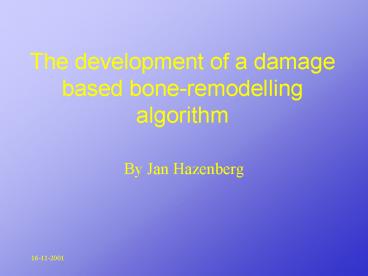The development of a damage based boneremodelling algorithm PowerPoint PPT Presentation
Title: The development of a damage based boneremodelling algorithm
1
The development of a damage based
bone-remodelling algorithm
- By Jan Hazenberg
2
overview
- Bone
- Hip-implants
- Bone remodeling
- Work done so far
- Further work
3
From skeleton to microstructure
4
Bone microstructure
5
Cortical versus trabecular bone
6
Osteocytes and canaliculi
7
Hip-implants
- Between 500,000 and 1 million hip implants per
year - 65 due to osteoarthritis (insert picture)
8
Failure No. 1
9
Types of implants
- Cemented
- Patients gt 60 years
- Cements with or without antibiotics
- High and low viscosity cement
- Uncemented
- Patients lt 60 years and exceptions
- Biological coating on the stem
10
Success of hip-replacement is depending on
Surgical factors Surgical experience and
skills Patient selection Prosthetic
factors Prosthetic materials Shape Prosthetic
fixation (cemented or press-fit) Surgical
instrumentation Patient factors Patient
compliance to surgical instructions Patient
activity Patient weight General health Patient
bone quality and quantity
11
Hip-replacement
12
Bone remodeling
- Bone a unique material
- Modeling
- Remodeling
- Adaptation
13
Basis Multi-cellular Units (BMU)
14
Stimuli proposed in literature
- Strain energy density
- Stress
- Strain
- Electrical stimuli
- Chemical stimuli
- Damage (fatigue due to cyclic loading)
- Osteocytes, the living cells in the structure are
assumed to sense these stimuli.
15
EFFECT OF HIP-IMPLANT ON BONE
16
CALCULATIONS AND VALIDATION OF FEA
17
Modeling the process
18
Work done so far 1
19
Work done so far 2
20
Work done so far 3
21
Work done so far 4
MSc. Eoin Bates The effect of fluid on the
stresses around the cracks in bone.
22
Approach for the stimulus
23
Damage tensor
- Aim is to develop a damage tensor as a function
of stress and the microstructure (age) of bone.
PowerShow.com is a leading presentation sharing website. It has millions of presentations already uploaded and available with 1,000s more being uploaded by its users every day. Whatever your area of interest, here you’ll be able to find and view presentations you’ll love and possibly download. And, best of all, it is completely free and easy to use.
You might even have a presentation you’d like to share with others. If so, just upload it to PowerShow.com. We’ll convert it to an HTML5 slideshow that includes all the media types you’ve already added: audio, video, music, pictures, animations and transition effects. Then you can share it with your target audience as well as PowerShow.com’s millions of monthly visitors. And, again, it’s all free.
About the Developers
PowerShow.com is brought to you by CrystalGraphics, the award-winning developer and market-leading publisher of rich-media enhancement products for presentations. Our product offerings include millions of PowerPoint templates, diagrams, animated 3D characters and more.

